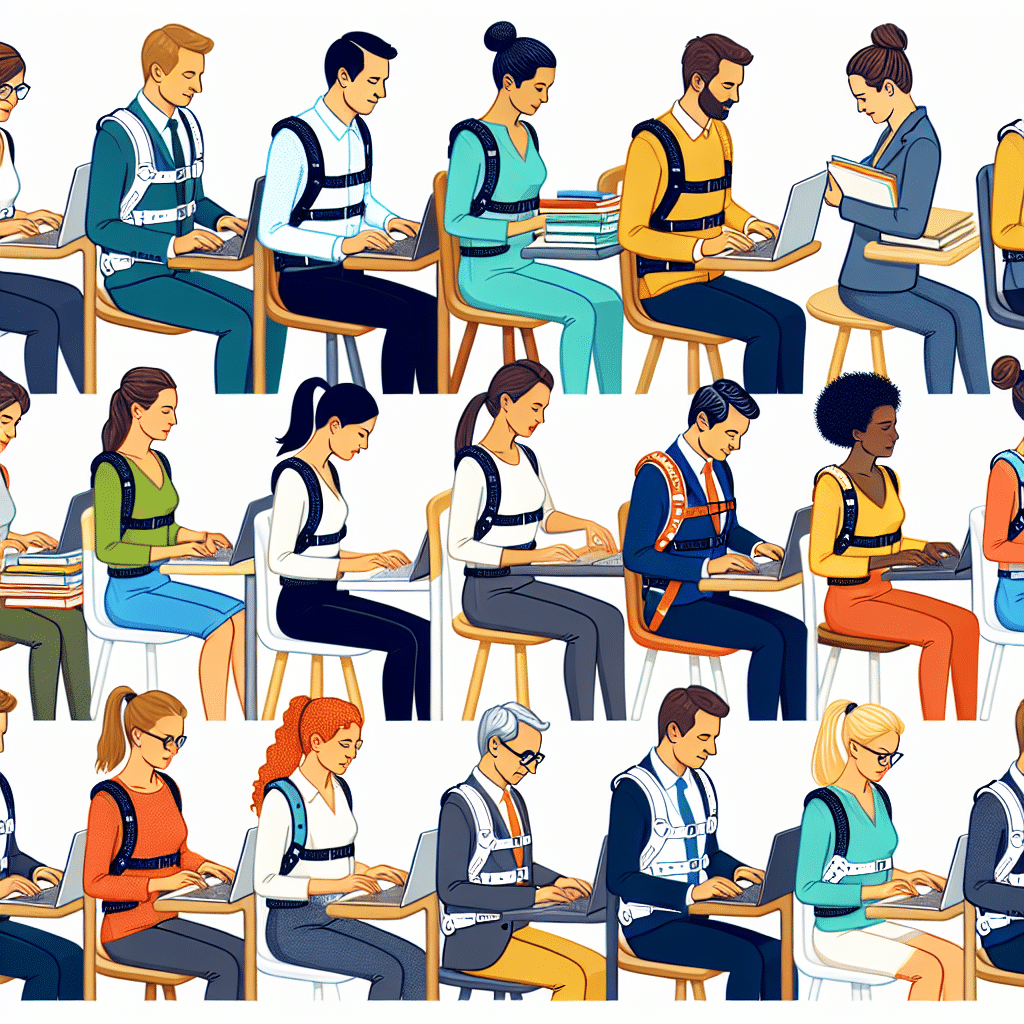Understanding Posture Correctors
Posture correctors are devices designed to assist individuals in achieving and maintaining an optimal posture. For students and professionals who frequently sit for long periods, these devices can be invaluable in mitigating the risks associated with poor posture, such as back pain and muscle tension. The importance of correct posture extends beyond physical health; it influences mental well-being, productivity, and overall quality of life.
Types of Posture Correctors
-
Shoulder Straps
Shoulder strap posture correctors are the most common type. They often resemble a soft harness worn over the shoulders, pulling them back to align with the spine. These are usually adjustable, making them suitable for various body types. Most models are discreet and can be worn under clothing, making them ideal for students and professionals alike. -
Braces
Posture braces are sturdier than shoulder straps and are often made of rigid materials. They provide more support and compression, which can be beneficial for those who experience significant back pain. They can target the upper back or lower back specifically, catering to different needs. -
Posture T-shirts
Innovative posture T-shirts incorporate built-in support into the fabric. They provide a gentle reminder to maintain good posture through compression and reinforcement, making them an excellent choice for daily wear in casual or professional settings. -
Smart Posture Correctors
Increased technological integration has led to the development of smart posture correctors. These can come in various forms, such as wearable devices or smartphone apps that monitor posture in real-time. They vibrate to alert the user when slouching occurs, making them particularly useful for tech-savvy students and professionals.
How Posture Affects Health
Poor posture can lead to a range of physical ailments, particularly for those who spend hours on end at desks or studying. Some common issues include:
- Back Pain: Slouching puts extra pressure on the lumbar spine, leading to chronic discomfort and pain.
- Neck Strain: Poor posture causes the neck to bend forward, which can trigger headaches and chronic neck pain.
- Digestive Problems: Slouching compresses the abdomen, potentially leading to digestive issues.
- Fatigue: Bad posture requires more energy from the body to maintain stability, leading to exhaustion over time.
Benefits of Using Posture Correctors
- Pain Relief: By improving alignment, best posture correctors can significantly reduce back and neck pain.
- Increased Energy Levels: Better posture allows for more efficient breathing and oxygen intake, which can increase energy.
- Enhanced Focus and Productivity: Good posture has been linked to increased concentration and productivity, particularly important for students during lengthy study sessions.
- Improved Confidence: Standing and sitting tall can impact self-esteem and how others perceive you, leading to newfound confidence in personal and professional settings.
Choosing the Right Posture Corrector
When selecting a posture corrector, several factors should be considered:
-
Comfort: The corrector should fit snugly without causing irritation or restricting movement. Look for materials that provide breathability, especially if worn for extended periods.
-
Size and Fit: Ensure the corrector is adjustable or comes in various sizes to fit your body type effectively. A proper fit will maximize the device’s effectiveness.
-
Ease of Use: Some posture correctors are easier to put on and take off than others. Opt for a design that fits into your routine seamlessly, whether for study sessions or work engagements.
-
Activity Level: If you plan to wear the corrector during exercise or active tasks, consider options that offer greater flexibility and support without impeding movement.
-
Reviews and Recommendations: Research customer reviews and seek recommendations from healthcare professionals or physical therapists when choosing.
Potential Downsides of Posture Correctors
While posture correctors offer various benefits, there are also some potential downsides to consider:
-
Over-Reliance: Continuous use may lead to weakened muscles, as the device does much of the work. It is essential to integrate exercises that strengthen postural muscles alongside usage.
-
Discomfort: Initial discomfort is common when adjusting to a posture corrector. Some users may abandon them because of irritations or soreness, underscoring the importance of proper fitting.
-
Limited Scope: No posture corrector is a standalone solution. Improving posture also requires ergonomic adjustments to workspaces, such as desk height and chair support, along with lifestyle changes.
Lifestyle Integrations for Better Posture
To achieve optimal posture, integrating a posture corrector into a broader approach is essential. Here are lifestyle tips that complement the use of these devices:
-
Ergonomic Workspaces: Invest in an ergonomic chair and desk setup. A chair with lumbar support helps maintain spinal alignment, while desks should be adjusted to the correct height.
-
Frequent Breaks: Encourage regular breaks to stand, stretch, and move around. Implementing the Pomodoro Technique (25 minutes of work followed by a 5-minute break) can promote healthier habits.
-
Strengthening Exercises: Engage in exercises targeting core strength, such as planks, bridges, and back extensions. Yoga and pilates also encourage flexibility and strength, crucial for maintaining good posture.
-
Body Awareness Practices: Mindfulness, meditation, and posture-focused exercises (like Alexander Technique or Feldenkrais Method) can develop awareness of body alignment and help cultivate good habits.
Creating a holistic approach that combines the use of posture correctors with ergonomic adjustments, regular breaks, strength training, and mindfulness practices will yield the best results in achieving and maintaining good posture for students and professionals alike.
